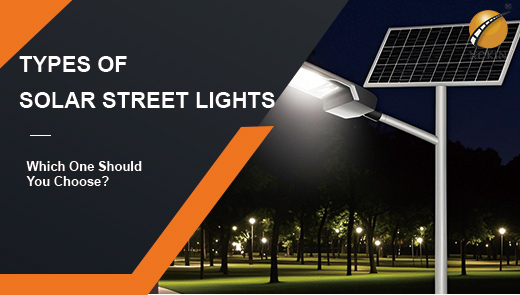Solar Street Light Components & Working Principle
In today's era of focusing on environmental protection and sustainable development, solar street lights, as a green and efficient lighting solution, are increasingly widely used in various fields. It can not only effectively reduce energy consumption and reduce the dependence on traditional electricity but also add a bright color to our living environment. Next, let's have an in-depth understanding of all the components of a solar street light and its working principle.
Solar street lights mainly rely on crystalline silicon solar cells to provide electricity, using the maintenance-free valve-regulated sealed batteries (gel batteries) to store electricity and the use of super-bright LED lamps as a light source, regulated by the intelligent charge and discharge controllers, in order to replace the traditional public power lighting street lamps. It is mainly composed of five core components, each of which plays an indispensable role in the whole lighting system.
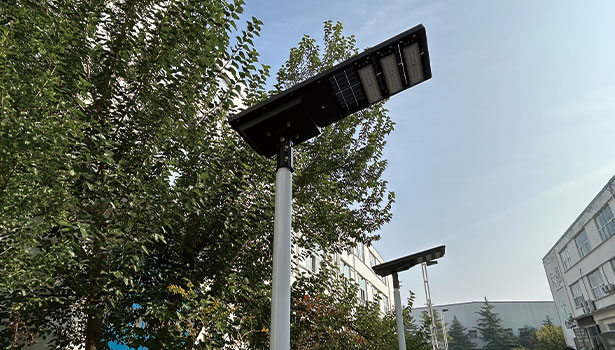
The Basic Structure and Function of Solar Street Lights
Solar Panel
Solar panels are generally divided into two types: monocrystalline and polycrystalline. Moreover, monocrystalline and polycrystalline are divided into A-side and B-side, which is why the price of the same configuration of solar panels on the market will have a big difference, and it is difficult for consumers to distinguish the difference intuitively. Their main function is to convert solar energy into electrical energy for storage in the battery. Currently, monocrystalline silicon solar panels have a conversion rate of up to 17%, while polycrystalline silicon has a conversion rate of about 12%. A higher conversion rate means that solar energy can be converted into electricity more efficiently, providing sufficient energy security for the normal operation of solar street lights.
Solar Cells
The solar cell assumes the important role of storing and releasing electricity. It can either be installed on the light pole or buried in the ground. When the battery is buried underground, the battery box can play a protective role to prevent the battery from being corroded by groundwater. The electricity converted by the solar photovoltaic module is stored in the battery, and at night it starts discharging under the command of the controller to provide the street light with the power needed for illumination.
Solar controller
The solar controller is called the “backbone” and “big heart” of the whole streetlight lighting system. Just as the health of a person's heart directly affects the body's function, the quality of the controller directly determines the service life of the solar street lamp lighting system. It is like an intelligent commander, precisely controlling the charging and discharging process, guaranteeing the whole system to run stably and efficiently. For example, in the charging process, it can reasonably adjust the charging current and voltage according to the state of the battery to avoid overcharging or undercharging the battery; in the discharging process, it can ensure the output of stable power to meet the working requirements of the LED light source.
LED light source
Nowadays, most high-quality solar street lamps on the market mostly use flat lampholders. The choice of light source is more diverse, mainly involving two key accessories: lamp holders and light-emitting chips. The traditional improved LED lamp base shell is large and has poor heat dissipation performance, while the plane lamp base not only looks flatter and more high-end but also has a built-in heat dissipation function. In terms of light source, there are domestic and imported. Due to the limitations of the relevant domestic technology, the current imported light source is dominated by, among them, Bridgelux and Coretronic products. They perform better; Bridgelux also has 33 and 45 and other different models to choose from. Different material choices make the price of the LED light source also have differences; a high-quality light source can often provide brighter, more stable lighting effects while having a longer service life.
Solar Street Light Pole
The pole is equipped with a light arm for connecting the light head. During installation, the pole needs to be combined with a cable buried deep in the ground. The pole part will be customized at the beginning of the design according to the customer's requirements on the pole type and configuration parameters. The size and style requirements of the light poles vary from customer to customer, resulting in a wide range of light pole prices. For example, some light poles with unique shapes and higher heights cost relatively more to make and are more expensive. Sturdy and durable light poles not only provide stable support for streetlights but also blend with the surrounding environment and play a certain decorative role.
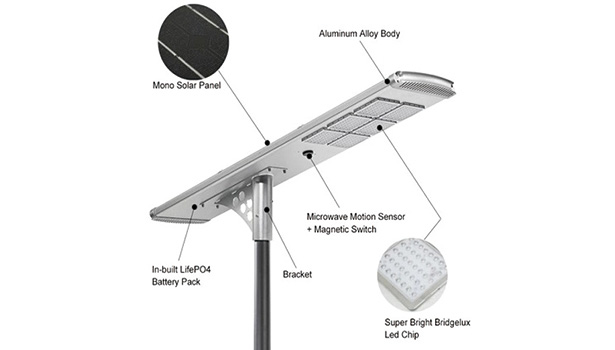
All-In-One Solar Street Light VS Split Solar Street Light
|
Feature |
Integrated Solar Street Light |
Split Solar Street Light |
|
Design & Configuration |
All key components, including the solar panel, battery, LED lamp, and charge controller, are integrated into a single compact unit, forming an independent system. It typically resembles traditional streetlights with a simple design, greatly simplifying installation. |
Components are separate; the solar panel is usually installed on top of the pole or on a nearby structure, while the LED lamp and battery are placed in different locations. This design offers more flexibility in component layout but makes installation more complex. |
|
Installation & Maintenance |
Due to its integrated design, minimal wiring and assembly work are required during installation. Maintenance is also relatively simple since all components are housed within one unit, making inspection and repairs easier—an ideal choice for areas with limited technical expertise. |
Installation requires placing the solar panel separately and connecting it to the lamp and battery, making the process more complex. Maintenance is also more cumbersome since multiple components need periodic inspection and servicing. |
|
Aesthetics |
The overall appearance is modern and sleek, blending well into urban environments without being obtrusive, adding a harmonious touch to city landscapes. |
Since components are separated, the overall look may lean towards a traditional or industrial style, which may be less visually appealing in settings that prioritize aesthetics. |
|
Efficiency |
Components are optimized to work together, achieving high efficiency in energy capture and storage. However, due to limitations in the size of the integrated solar panel and battery, its capacity and overall efficiency may have an upper limit. |
More flexibility in choosing the size and orientation of the solar panel, allowing optimization based on the actual environment. This results in higher energy capture efficiency. Additionally, larger solar panels and batteries can be accommodated, increasing system capacity and extending lighting duration. |
|
Adaptability |
Well-suited for general street lighting in urban and suburban areas. Its compact design allows easy deployment in various environments to meet standard lighting needs. |
Highly versatile and customizable, allowing flexible configurations based on specific lighting requirements. Especially suitable for remote areas or special lighting needs, such as mountainous regions and large construction sites. |
|
Cost |
Due to simplified design and installation, initial procurement costs may be relatively low. However, long-term maintenance costs can vary depending on component quality. |
Initial procurement costs are higher since multiple components must be purchased and installed separately. However, in large-scale projects, its efficient energy capture and storage capabilities can lead to lower long-term operational costs, offering better cost-effectiveness. |
Do All-In-One Solar Street Lights and Integrated Solar Street Lights Work the Same Way?
Integrated solar street lights and integrated solar street lights are basically the same in the working mode of the energy conversion process. They both use components such as monocrystalline or polycrystalline silicon solar panels, lead-acid or lithium-ion batteries (e.g., LiFePO₄ batteries), PWM or MPPT charge controllers, and LED light sources. However, there are some differences between the two, with all in one solar street lights integrating all the components into a single unit, while the solar panels of integrated solar street lights exist as a separate unit. Regardless of the type, solar street lights are designed to provide continuous illumination at night for road safety while creating a sophisticated and cozy atmosphere in the installation area.
How Does the All-In-One Solar Street Light Work?
Sunlight Absorption
During the daytime when there is sufficient light, the solar panel on top of the integrated solar street light actively absorbs sunlight. Its internal photovoltaic cells can convert the absorbed sunlight into direct current, which is the starting step of the whole energy conversion process, laying the foundation for the subsequent storage and utilization of electric energy.
Battery charging
The converted direct current is transferred to a rechargeable battery below the solar panel. As long as the sun shines, the batteries continue to be charged. During the day, the battery's charge builds up over time, reserving enough energy for lighting at night.
Automatic activation
When night falls and the ambient light gradually diminishes (usually at dusk or when the light sensor detects darkness), the intelligent control system inside the integrated solar street light will react quickly and automatically activate the LED light source to ensure that the all in one solar street light can provide timely lighting for the road.
Nighttime Lighting
Throughout the night, the LED lights continue to emit light by virtue of the power stored in the battery, providing stable and reliable lighting for pedestrians and vehicles. The brightness of the light output is carefully designed to meet specific lighting needs, ensuring road safety and visibility at night.
Morning Shutdown
With the arrival of dawn, the sunlight pours down again, and the solar panels start working again to continue charging the batteries for the next night. At the same time, the intelligent control system will automatically turn off the LED lights, avoiding unnecessary energy consumption and realizing the efficient use of energy.
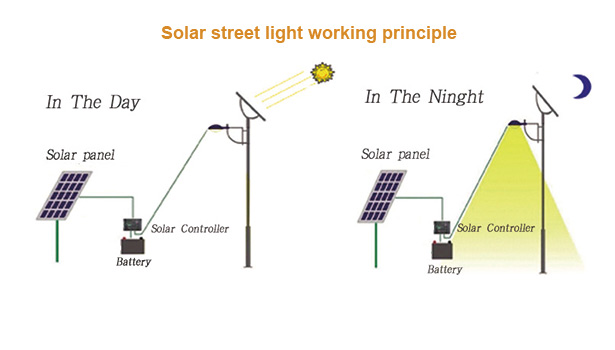
How Smart Solar Street Lights Work?
Solar panels collect solar energy.
The photovoltaic module (i.e., solar panel) of the smart solar street light can keenly detect and absorb sunlight. Currently, the more common types of solar panels in the solar power industry are monocrystalline and polycrystalline. Monocrystalline silicon solar panels are widely used in solar street light technology due to their ability to capture solar energy efficiently even in cold weather. The solar panels are mounted on top of the light poles via aluminum brackets, and some of the designs also offer a certain degree of flexibility in that the angle of the solar panels can be adjusted to better adapt to different lighting conditions and collect solar energy more efficiently.
Rechargeable batteries convert and store energy.
Solar street lights are equipped with rechargeable batteries. The solar energy captured by the solar panels is transferred to the rechargeable battery, which stores the energy collected during the day and releases it at night to power the LED lights. This type of rechargeable battery is a deep-cycle battery, which can continuously output current for a long period of time and still maintain good performance during multiple charging and discharging processes. Generally speaking, solar street light batteries are designed to have a high charge/discharge capacity, usually with more than a day's charge reserve, and a typical design ensures that lighting needs can still be maintained for about 5 days in low light conditions such as winter and rainy seasons. The two main types of deep-cycle batteries commonly used in the solar lighting industry are lead-acid batteries and lithium batteries.
Intelligent controller regulates energy and communication.
The smart controller plays a key role in regulating the entire system. It can effectively manage the stored energy and prevent the battery from being overcharged. Installed between the solar panel and the rechargeable battery, the smart controller is responsible for receiving signals from these two components and accurately regulating the voltage and current levels transmitted from the solar panel according to the signals. In solar lighting technology, there are mainly two kinds of intelligent controllers, PWM and MPPT. Most modern solar LED street lights use MPPT charging controllers because they have higher reliability and charging efficiency compared to PWM.
As one of the core components of the solar street light, the intelligent controller mainly has the following control functions:
Dusk to dawn control:
Continuously monitor the voltage changes; automatically turn on the LEDs when the input voltage is detected to decrease; when the voltage increases, instruct the LEDs to turn off so as to realize the automatic lighting control of the solar led street light from dusk to dawn.
Time control:
For example, the brightness of streetlights is intelligently adjusted at different times. From 6pm to 7pm, the brightness can be set to 70%; from 8pm to 10pm, it reaches 100%; and from 11pm to 5pm, it is adjusted to 30% brightness. When the sensor detects someone's activity, no matter what time of the night, the streetlight will automatically switch to 100% brightness, which not only meets the lighting demand but also realizes reasonable energy saving.
Motion Sensing:
There are two main types of motion sensors: microwave and infrared. Infrared motion sensors sense motion by detecting heat emitted by objects or the human body, while microwave sensors rely on receiving reflected signals to determine whether an object is moving. When the motion sensor detects movement within a certain distance (usually 5-6 meters), it will immediately turn on the solar LED street light to provide illumination for pedestrians.
Low Voltage Disconnect Protection:
Overcharging can seriously affect the performance and service life of the battery. The intelligent charge controller effectively prevents overcharging of the battery by monitoring the battery voltage in real time and takes timely measures to avoid over-discharging of the battery when low voltage is detected, thus protecting the battery and prolonging its service life.
Remote management software realizes remote monitoring.
Remote management software enables real-time, proactive monitoring of the street light's lighting brightness and other performance, avoiding excessive consumption of electricity by the street light and thus reducing operating costs. It can comprehensively and accurately report the operation status of the solar powered street light system. The owner or manager of the streetlight can remotely monitor and control each streetlight through devices such as cell phones, computers, or tablet PCs, realizing intelligent lighting management, which greatly improves management efficiency and convenience.
LED Lights for Dusk to Dawn Lighting
When night comes, the electricity stored in batteries is used to drive LED lights. LED lamps are widely used in solar streetlights because of their energy-efficient properties. LEDs in solar LED street lights usually only illuminate from dusk to dawn, typically for about 12 hours, and the brightness is adjusted according to a setting during this period. As mentioned earlier, during peak hours, the streetlight is illuminated at full brightness; after the peak hours, it is automatically dimmed; and when the sensor detects a person, it is immediately and automatically adjusted to full brightness to meet the lighting needs in different scenarios.
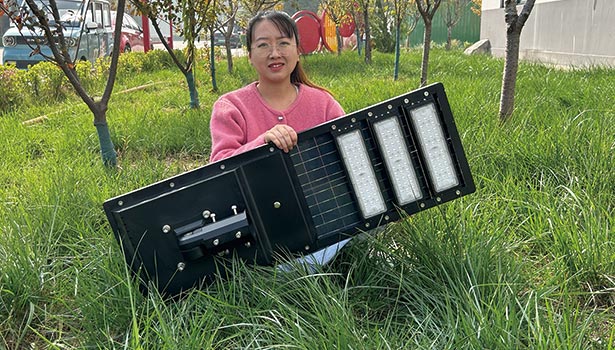
Faults and solutions of solar street lights
|
Issue: Street Light Not Working |
Analysis |
Solution & Maintenance |
|
Switch Not Turned On |
Check if the switch is in the ON position. |
Turn on the switch. |
|
Switch Malfunction |
Short-circuit the switch wires; if the light turns on, the switch is faulty. |
Replace the switch. |
|
Battery Depleted |
Could be due to prolonged rainy days or improper installation. Remove the light fixture, disconnect the battery, and use a multimeter to check the battery voltage. If the output voltage is below 11V, the battery is likely depleted or insufficient. |
Charge the battery using the solar panel during the day and turn off the switch at night to stop discharging. It usually takes 2-3 days to fully recharge. |
|
Battery Damaged |
The battery has reached the end of its lifespan and can no longer charge or discharge properly. |
Replace with a new battery. |
|
LED Street Light Malfunction |
The LED light may have short-circuited or been damaged by a lightning strike. |
Replace the LED light fixture. |
|
Solar Controller Burned Out |
Check whether the controller's indicator lights are functioning normally. |
Replace with a new solar controller. |
|
Issue: Short Lighting Time |
Analysis |
Solution & Maintenance |
|
Low Battery Power |
The installation position of the light is improper, or the solar panel is covered by dust, leaves, etc., reducing its charging efficiency. Check if the solar panel is obstructed, then remove the light fixture and use a multimeter to measure the battery voltage. If the voltage is below 11V, the battery is likely depleted. |
1. Clean the solar panel. 2. Charge the battery during the day using the solar panel, and turn off the switch at night to stop discharging. It usually takes 2-3 days to fully recharge. |
|
Incorrect Settings |
The factory-set lighting time is too short. |
Use the remote control to reset the lighting duration. |
|
Issue: Low Solar Panel Charging Efficiency |
Analysis |
Solution & Maintenance |
|
Solar Panel Covered |
The solar panel is covered by dust, leaves, etc., leading to insufficient charging of the battery. |
Clean the solar panel and adjust its angle to optimize sunlight exposure. |
|
Issue: Street Light Stays On During the Day |
Analysis |
Solution & Maintenance |
|
Poor Solar Panel Wiring |
Wiring issues have caused an open circuit or reversed polarity of the solar panel. |
Reconnect the wiring properly. |
|
Photocell Malfunction |
The built-in photocell is not functioning correctly. |
Replace the solar controller. |
|
LED Chip Partially Damaged |
Open the street light and use a multimeter to check if the LED chip has a valid voltage. If not, the LED chip is burned out. |
Replace the LED chip or the entire LED streetlight. |
|
Issue: Street Light Flickering |
Analysis |
Solution & Maintenance |
|
Poor Wiring Connection |
The battery connection is incorrect, and power from the solar panel is directly supplying the light source, causing flickering. |
Reconnect the wiring properly. |
|
Battery Malfunction |
Check if the battery is under-voltage or depleted. The controller will indicate this issue, and for a 12V system, the under-voltage protection threshold is around 11.1V. If under-voltage is confirmed, the battery can only be recharged using the solar panel or a DC charger. The light will only turn on once the battery voltage exceeds 12V. |
Replace with a new battery. |
|
Issue: Sensor Malfunction (Mainly for Integrated or All-in-One Street Lights) |
Analysis |
Solution & Maintenance |
|
Sensor Device Failure |
When a person or any moving object approaches the solar street light, the brightness does not change. |
Replace the sensor device. |
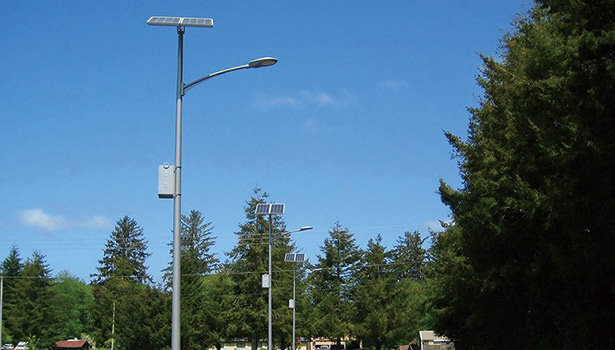
With its unique component design and scientific working principle, a solar street light provides us with an environmentally friendly and efficient lighting option. Although some failures may occur during use, by understanding its working mechanism and solutions to common problems, we are able to better maintain and utilize the solar powered street light so that it can play a greater role in the lighting field and bring more convenience and greenery to our lives.


